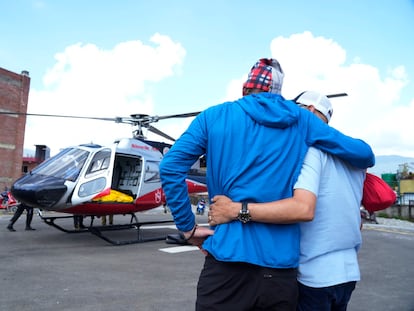Ten years without Patrick Edlinger, the ‘blond god’ of climbing
Next November marks a decade since the passing of the French climber, who paved the way for rising stars such as mountaineer Seb Bouin
Next November marks a decade since the passing of Patrick Edlinger, just as another French climber, Seb Bouin, astonishes the world by climbing the seemingly impossible. Young Bouin, 29, may not know it, but it was Edlinger who, in the 1980s, brought climbing out from obscurity and gave it aesthetic, ethical and philosophical meaning. This philosophy was shared by a generation that came up with what we now know as sport climbing. Except that then it was not about sports. What’s more, Edlinger tried to give his life meaning, freedom, the simplicity of the sublime, and had the great fortune of finding an accomplice, Jean Paul Janssen, who was able to elegantly convey his message in the 1982 movie, La Vie Au Bout des Doigts (or, Life by the Fingertips). The film showed Edlinger, who was barely 22 at the time, wearing shorts, with his blond hair tied with a fine ribbon, hanging in the void by one hand. It introduced France to “Le Blonde,” the so-called “blonde god” from another planet who climbs mountains without a rope and performs actions that first attract, and then repel, any idea of death.
Edlinger was 52 years old and under the shadow of a deep depression when he was found dead in his home in 2012. There was some talk of suicide. Others note that he fell down the stairs, just as his close friend, Patrick Berhault, had fallen to his death during a trek across the Alps.
Seb Bouin is what is now known as a global athlete: last May he announced he had completed his DNA project, one of the two presumably most difficult routes ever climbed, and his picture was all over the covers of both the specialized climbing magazines and the general press. He leads a simple life: training and resting. A low-profile life, not unlike the one that Edlinger wanted for himself. Edlinger would not come to know the current climbing boom, and it is not easy to know if he would have appreciated the rise of indoor climbing walls, where many climb with no intention whatsoever of making the leap to real mountains. Like a person who goes to a spinning class, but does not wish to feel the air on their face while cycling on the road.
Ironically, the first climbing wall could have been the house that Edlinger built next to his home, a building dubbed the “Temple,” which contained wooden panels full of climbing holds. Here, he and his friends indulged in endless training sessions: 1,000 pull-ups for breakfast and 1,000 more before going to bed, stretching and running. Edlinger and his disciples systematized their training, they experimented with their body, subjecting it to any kind of torture that may hold the promise of improvement. Later, he would assert that he was overtrained for half his life. Now that alpinism has become an Olympic sport, it is worth mentioning that the first competition was only held in 1985. In 1986, Edlinger attended the second edition to silence those who called him a marketing product. Not only did he win the competition: he won by far.
Seb Bouin also wanted to compete, but he had a bad experience with the coach who was training him and decided to turn to the mountain, where he could set his own rules. After proving he was the best, Edlinger dropped out of the competition too. He needed to travel, to be in touch with nature. And to climb without a rope; this would allow him to travel far into the zone of fear and get to know himself better, as he himself would later write in an autobiography that he never lived to see published.
Until fame knocked on his door and a French rope manufacturer Michel Béal decided to become his patron, Edlinger and his entourage survived by occupying old mansions at the Verdon, stealing jars of Nutella and mountain books. In order to avoid military service, Edlinger pretended to be mentally ill, which would cost him three months in a psychiatric hospital.
Today it is the powerful American sports equipment company, Black Diamond, that allows Bouin to devote his life to climbing. His spectacular videos, unlike the films and documentaries in which Edlinger appeared, are not seen with the family during prime time, but on the cell phone. Climbing is without a doubt more present than ever, but for the surviving pioneers of the 1980s, it is just another consumer product, devoid of any mystique.
The film Life by the Fingertips cost 150,000 francs (around $20,000) and was sold to 25 countries. Edlinger’s popularity took him to Parisian parties, sparked a romance with a movie star and guaranteed contracts; he was as famous as Yannick Noah, Bernard Hinault, Michel Platini, Sophie Marceau or Gérard Depardieu. Paris Match magazine presented his climbing trips in ten-page articles. And when the tide subsided, he still had the mountain. Freedom. With his angelic face, in the blink of an eye Edlinger said goodbye to his fame, which made him smile, but that was ultimately unnecessary. All he wanted was to climb. Bouin looks for the same thing. His motivation comes from the challenge of achieving the impossible, of going further than anyone else in the sport side of climbing. Even if it hurts. He does not smoke like Edlinger, nor does he take part in night races with powerful cars. He also does not do “free solo” climbing, a practice that his predecessor left after his daughter was born. Same passion. Same capacity for action. Different life philosophies.
When Edlinger started to suffer from depression and alcohol problems, he took stock of his life: he could count his friends on one hand. His best climbing years were behind him. He missed Patrick Bérhault, his equal. After a near-fatal fall in France, he suffered a brief cardiac arrest. At that moment, he said, he felt joy. He loved life and was not afraid to die. His biography states that after the fall, he returned to training and regained his excitement for climbing – the same passion that today motivates thousands of climbers to test themselves, not against life-threatening mountain routes, but against challenging climbing walls. Ten years have not passed since the death of the blonde god of climbing.
Tu suscripción se está usando en otro dispositivo
¿Quieres añadir otro usuario a tu suscripción?
Si continúas leyendo en este dispositivo, no se podrá leer en el otro.
FlechaTu suscripción se está usando en otro dispositivo y solo puedes acceder a EL PAÍS desde un dispositivo a la vez.
Si quieres compartir tu cuenta, cambia tu suscripción a la modalidad Premium, así podrás añadir otro usuario. Cada uno accederá con su propia cuenta de email, lo que os permitirá personalizar vuestra experiencia en EL PAÍS.
¿Tienes una suscripción de empresa? Accede aquí para contratar más cuentas.
En el caso de no saber quién está usando tu cuenta, te recomendamos cambiar tu contraseña aquí.
Si decides continuar compartiendo tu cuenta, este mensaje se mostrará en tu dispositivo y en el de la otra persona que está usando tu cuenta de forma indefinida, afectando a tu experiencia de lectura. Puedes consultar aquí los términos y condiciones de la suscripción digital.
More information
Últimas noticias
Most viewed
- Sinaloa Cartel war is taking its toll on Los Chapitos
- Oona Chaplin: ‘I told James Cameron that I was living in a treehouse and starting a permaculture project with a friend’
- Reinhard Genzel, Nobel laureate in physics: ‘One-minute videos will never give you the truth’
- Why the price of coffee has skyrocketed: from Brazilian plantations to specialty coffee houses
- Silver prices are going crazy: This is what’s fueling the rally











































